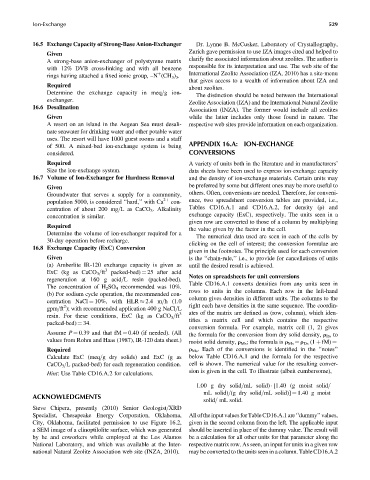Page 574 - Fundamentals of Water Treatment Unit Processes : Physical, Chemical, and Biological
P. 574
Ion-Exchange 529
16.5 Exchange Capacity of Strong-Base Anion-Exchanger Dr. Lynne B. McCusker, Laboratory of Crystallography,
Zurich gave permission to use IZA images cited and helped to
Given
clarify the associated information about zeolites. The author is
A strong-base anion-exchanger of polystyrene matrix
responsible for its interpretation and use. The web site of the
with 12% DVB cross-linking and with all benzene
International Zeolite Association (IZA, 2010) has a site-menu
rings having attached a fixed ionic group, –N (CH 3 ) 3 .
þ
that gives access to a wealth of information about IZA and
Required
about zeolites.
Determine the exchange capacity in meq=g ion-
The distinction should be noted between the International
exchanger.
Zeolite Association (IZA) and the International Natural Zeolite
16.6 Desalination
Association (INZA). The former would include all zeolites
Given while the latter includes only those found in nature. The
A resort on an island in the Aegean Sea must desali- respective web sites provide information on each organization.
nate seawater for drinking water and other potable water
uses. The resort will have 1000 guest rooms and a staff
of 500. A mixed-bed ion-exchange system is being APPENDIX 16.A: ION-EXCHANGE
considered. CONVERSIONS
Required A variety of units both in the literature and in manufacturers’
Size the ion-exchange system. data sheets have been used to express ion-exchange capacity
16.7 Volume of Ion-Exchanger for Hardness Removal and the density of ion-exchange materials. Certain units may
Given be preferred by some but different ones may be more useful to
Groundwater that serves a supply for a community, others. Often, conversions are needed. Therefore, for conveni-
population 5000, is considered ‘‘hard,’’ with Ca 2þ con- ence, two spreadsheet conversion tables are provided, i.e.,
centration of about 200 mg=L as CaCO 3 . Alkalinity Tables CD16.A.1 and CD16.A.2, for density (r)and
concentration is similar. exchange capacity (ExC), respectively. The units seen in a
given row are converted to those of a column by multiplying
Required
the value given by the factor in the cell.
Determine the volume of ion-exchanger required for a
The numerical data used are seen in each of the cells by
30-day operation before recharge.
clicking on the cell of interest; the conversion formulae are
16.8 Exchange Capacity (ExC) Conversion
given in the footnotes. The principle used for each conversion
Given is the ‘‘chain-rule,’’ i.e., to provide for cancellations of units
(a) Amberlite IR-120 exchange capacity is given as until the desired result is achieved.
3
ExC (kg as CaCO 3 =ft packed-bed) ¼ 25 after acid
Notes on spreadsheets for unit conversions
regeneration at 160 g acid=L resin (packed-bed).
Table CD16.A.1 converts densities from any units seen in
The concentration of H 2 SO 4 recommended was 10%.
rows to units in the columns. Each row in the left-hand
(b) For sodium cycle operation, the recommended con-
column gives densities in different units. The columns to the
centration NaCl ¼ 10%, with HLR 2.4 m=h (1.0
2
gpm=ft ); with recommended application 400 g NaCl=L right each have densities in the same sequence. The coordin-
resin. For these conditions, ExC (kg as CaCO 3 =ft 3 ates of the matrix are defined as (row, column), which iden-
tifies a matrix cell and which contains the respective
packed-bed) ¼ 34.
conversion formula. For example, matrix cell (1, 2) gives
Assume P ¼ 0.39 and that fM ¼ 0.40 (if needed). (All the formula for the conversion from dry solid density, r Ds to
values from Rohm and Haas (1987), IR-120 data sheet.)
moist solid density, r Ms ; the formula is r Ms ¼ r Ds (1 þ fM) ¼
Required r Ms . Each of the conversions is identified in the ‘‘notes’’
Calculate ExC (meq=g dry solids) and ExC (g as below Table CD16.A.1 and the formula for the respective
CaCO 3 =L packed-bed) for each regeneration condition. cell is shown. The numerical value for the resulting conver-
sion is given in the cell. To illustrate (albeit cumbersome),
Hint: Use Table CD16.A.2 for calculations.
1.00 g dry solid=mL solid) [1.40 (g moist solid=
mL solid)=(g dry solid=mL solid)] ¼ 1.40 g moist
ACKNOWLEDGMENTS
solid= mL solid.
Steve Chipera, presently (2010) Senior Geologist=XRD
Specialist, Chesapeake Energy Corporation, Oklahoma, All oftheinput valuesfor Table CD16.A.1 are ‘‘dummy’’values,
City, Oklahoma, facilitated permission to use Figure 16.2, given in the second column from the left. The applicable input
a SEM image of a clinoptilolite surface, which was generated should be inserted in place of the dummy value. The result will
by he and coworkers while employed at the Los Alamos be a calculation for all other units for that parameter along the
National Laboratory, and which was available at the Inter- respective matrix row. As seen, an input for units in a given row
national Natural Zeolite Association web site (INZA, 2010). may be converted to the units seen in a column. TableCD16.A.2

